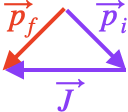Bouncing Off Walls
Impulse and momentum is a particularly helpful tool in studying collisions. Collisions are complicated physical processes, with a force (and thus an acceleration) that varies constantly as we saw in Impulse. Because the acceleration is not constant, we cannot use The Five Equations from kinematics.
Consider this ball (with mass $m$) bouncing off a wall. While we don't know how the force on the ball varies, we do know that it is a normal force, and so it must be a perpendicular push on the ball by the wall— namely, a force to the left. That means that the total impulse on the ball must also be to the left; let's call it $\PURPLE{\vec J=(-J,0)}$ for some value of $J$. If we call the ball's velocity right before it hits the wall $\BLUE{\vec v_i=(v_{ix},v_{iy})}$, and its velocity right after it hits the wall $\RED{\vec v_f=(v_{fx},v_{fy})}$, then according to Momentum:

$$\begin{align} \RED{\vec p_f} &= \BLUE{\vec p_i} + \PURPLE{\vec J}\\ \RED{(mv_{fx},mv_{fy})}&=\BLUE{(mv_{ix},mv_{iy})}+\PURPLE{(-J,0)}\\ \end{align}$$ Since this is a vector equation, it can be split into a horizontal and a vertical equation: $$\begin{align} mv_{fx}&=mv_{ix}-J\\ mv_{fy}&=mv_{iy}\\ \end{align}$$ In other words, the horizontal impulse only affects the horizontal component of the velocity; the vertical component of the velocity is not changed by the bounce.
Now if you think about this for a while, you might think "But wait, what about gravity? Gravity is a vertical force, so why doesn't the impulse have a vertical component from gravity too?" It's true that gravity is important during most of the ball's motion: before and after the collision, the ball will continue to speed up in the downward direction. However collisions are so brief, and their forces are so large, that the impulse due to the collision is much larger than the impulse of gravity during the same amount of time, so that we can ignore the contribution of gravity during the collision itself.
Example
Example

A 2kg ball hits a vertical wall with a velocity of (4,-3)m/s and bounces off with a velocity of (-1,-3)m/s. (Notice how the vertical component of the velocity stays the same!) The change in momentum is $$\begin{align} {\color{red}\vec p_f}-{\color{blue}\vec p_i}&={\color{red}(2\u{kg})(-1,-3)\u{m/s}} - {\color{blue}(2\u{kg})(4,-3)\u{m/s}}\\ &=(-2,-6)\u{Ns} - (8,-6)\u{Ns}\\ &=(-10,0)\u{Ns}\\ \end{align}$$ so the impulse is $J=10\u{Ns}$ to the left. If the collision lasts a millisecond (a reasonable guess), then the average force of the wall on the ball is $$F_{avg}={J\over \Delta t}={10\u{Ns}\over 0.001\u{s}}=10,\!000\u{N}.$$ During the collision, the impulse of gravity on the ball is only $$mg\Delta t=(2\u{kg})(9.8\u{N/kg})(0.001\u{s})\approx0.02\u{Ns},$$ much smaller than the impulse from the collision.